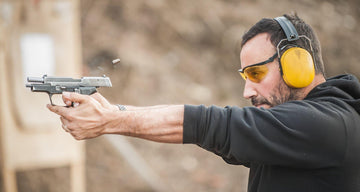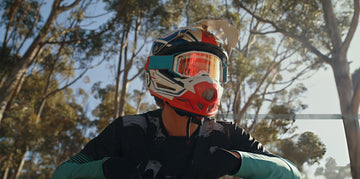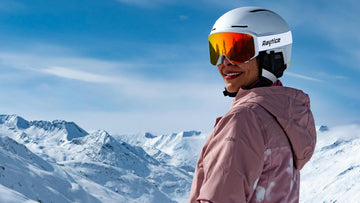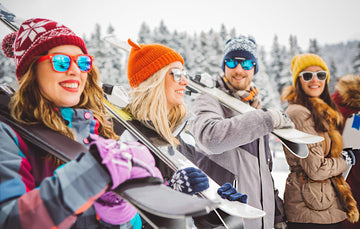As winter sport skiers know, the right gear is as important for safety as for performance. Not just for winter sports - having the right gear for any sport activity you engage in is a must. With the right sunglasses or goggles based on the sport your child is interested in, you can ensure better protection and care.
Now, choosing ski goggles for your child's eye protection matters to their enjoyment and safety on the slopes. Read everything you need to know to pick your child's ski goggles.
Why Kids Need Specialized Ski Goggles?
Some people think ski goggles for kids are just smaller versions of adult goggles. But the nature of kids' gear varies greatly. A child's face has unique features and proportions that require goggles made specifically for them. If you give your adult gear to kids, they will face pressure points and gaps on their small faces.
Besides, the American Academy of Ophthalmology addressed that 90% of eye injuries could be prevented by wearing appropriate protective eyewear. So if your kids are taking part in winter sports, their eyes need to be equipped with fitting eyewear for protection in case of intense weather conditions and possible accidents during activities like skiing and snowboarding.
Ignoring eye protection might have serious effects. Children who proceed without junior goggles to ski that fit properly run the danger of suffering from discomfort that could last a long time to permanent harm.
How Do I Choose the Right Size Ski Goggles for Kids?
If you have decided to buy kids ski goggles, here is a quick guide on how to pick the right size:
Ensuring Proper Size and Fit
Knowing your child's facial measurements is the first step in choosing the appropriate size. The most precise technique is to measure from cheekbone to eyebrow and from temple to temple. You can use these metrics as a starting point for comparing various models.
A properly fitted goggle should create a complete seal around the eyes without applying excessive pressure at any point. The foam should make contact with the skin all the way around, leaving no gaps that could let in cold air or snow.
Understanding Lens Technology
Modern ski goggle lenses have evolved significantly, offering various features that enhance visibility and protection. UV protection serves as the foundation of any quality lens, blocking harmful UVA and UVB rays that are especially intense at higher altitudes. The American Vision Council emphasizes that children's eyes are particularly susceptible to UV damage, making this feature non-negotiable.
For varying weather conditions, different lens types serve specific purposes. Clear-weather lenses typically feature darker tints and higher VLT (Visible Light Transmission) percentages to manage bright sunlight effectively. On the other hand, low-light lenses use rose or yellow tints to improve depth perception and contrast in cloudy or snowy environments.
Frame Design and Material Considerations
The frame's construction plays a vital role in both durability and comfort. High-quality frames utilize flexible materials that can withstand impacts while maintaining their shape.
The ventilation system should facilitate adequate airflow without compromising the goggle's protective seal. Premium models often feature multi-layer foam padding, with hypoallergenic materials closest to the skin to prevent irritation during extended wear.

Helmet Integration
Since helmet use is emphasized in modern skiing, goggle-helmet compatibility is crucial. By keeping the goggle frame flush with the helmet, the dreaded "gaper gap" that allows moisture and chilly air to enter should be closed. OTG (Over The Glasses) styles give kids who wear prescription glasses more room without sacrificing the protective features of the goggles.
Adjustability Features
Growing children require equipment that can adapt to their changing needs. Quality junior ski goggles feature easily adjustable straps with secure locking mechanisms that prevent slipping. Some models offer adjustable nose bridges, allowing for customization as your child grows. These features ensure long-term value and consistent performance throughout multiple seasons.

Anti-Fog Capabilities
Your ski goggles must not fog up due to the extremely cold climates. To avoid this, make sure your child has kids ski goggles with anti-fogging features. These goggles are made with unique ventilation systems and anti-fog coating. It will keep your child’s vision clear even when the environment is very cold or windy.
Best Practices for Selection and Testing
When evaluating the best ski goggles for youth, conduct a thorough fitting session with your child wearing their ski helmet. Pay attention to their comfort level after several minutes of wear, as pressure points may not be immediately apparent. To make sure the goggles remain firmly in place without moving, have them move their head in all directions.
Consulting with an eye care specialist can assist in identifying the best option for kids who need prescription eyewear, whether it's OTG goggles or prescription inserts. On the slopes, this extra precaution guarantees the best possible eyesight and safety.
Maintenance and Care Guidelines
When your child's ski goggles are properly maintained, their lifespan is greatly increased. Paper items can harm the surface of clean lenses, so only use a microfiber cloth to handle them. If you are not using the goggles, keep them in a case to protect them from heat and moisture.
- Scratched lenses
- Compressed foam that no longer forms an adequate seal
- Broken straps that jeopardize security
Safe Skiing Tips
Safety is paramount when introducing children to skiing, and proper preparation begins before they ever hit the slopes. Young skiers must be equipped with well-fitting safety gear, including a properly sized helmet that meets current safety standards, appropriate winter clothing that allows free movement while providing warmth, and correctly adjusted ski bindings that will release when needed.
Parents and instructors should ensure children undergo basic training in fall prevention, stopping techniques, and lift safety protocols, creating a strong foundation for safe skiing practices that will last a lifetime.
On the slopes, children should be taught to ski at controllable speeds and always stay within their skill level, gradually progressing from beginner runs to more challenging terrain as their abilities improve. Regular breaks are essential to prevent fatigue, which can lead to accidents, and children should be encouraged to communicate openly about any discomfort or concerns they experience while skiing.
Creating a positive environment where safety consciousness is celebrated helps young skiers develop good judgment and responsible skiing habits, ensuring they can enjoy the sport safely for years to come.
Conclusion
Choosing kid’s ski goggles is an investment in their love of winter sports as well as their safety. Children's goggles from Raytice are the ideal combination of cutting-edge protection, comfort, and durability that young skiers require.
The newest lens technology is included in the best ski goggles for youth while preserving the key characteristics that parents want in safe eyewear. Check out our selection of child ski goggles, each one is made to offer the best possible protection and functionality for eager winter athletes.
Frequently Asked Questions
Q: Do goggles come with changeable frames?
A: Modern ski goggles for kids often feature interchangeable lens systems, though complete frame changes are uncommon. Some premium models offer quick-change lens mechanisms. These models are designed specifically for varying weather conditions and light situations.
Q: Can my child wear contact lenses or glasses with kid's ski goggles?
A: Yes, there are solutions for kids with vision correction needs. OTG junior goggles to ski are specifically designed to accommodate prescription eyewear, featuring extra space and ventilation to prevent fogging. Alternatively, prescription insert options can be fitted directly into certain goggle models, providing a more streamlined solution.
Q: Are polarized lenses necessary for ski goggles for kids?
A: Polarized lenses are not mandatory, but they provide young skiers with many benefits. The glare from snow and ice, which can be especially strong at high elevations, is lessened by these specialty lenses. Better sight, less eye strain, and improved contrast perception result from the decreased glare.
Q: How do I prevent my kids' ski goggles from fogging up?
A combination of appropriate gear and appropriate use can effectively manage goggle fogging. Start with goggles that have sufficient ventilation systems and high-quality anti-fog coating. Never wipe the interior of the lens to preserve the anti-fog coating.
Make sure it fits properly and has no openings that could let warm air in from underneath. The anti-fog qualities will be maintained throughout the season with regular care and appropriate storage away from heat sources.





